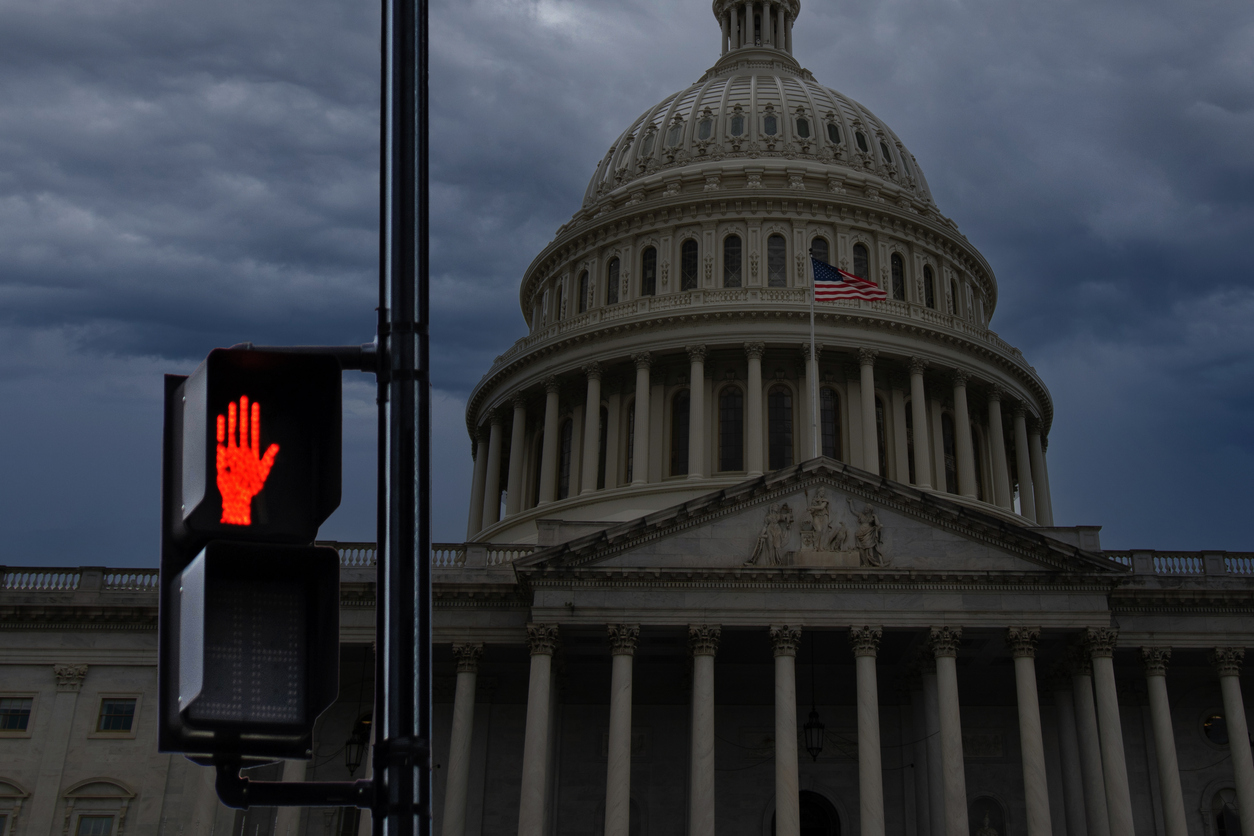Client Alerts
Looming Government Shutdown and a Practical Approach for Government Contractors
November 2023

Client Alerts
Looming Government Shutdown and a Practical Approach for Government Contractors
November 2023
Quickly approaching is Congress’s deadline to pass spending legislation, and without coming to an agreement soon, the federal government faces the possibility of another shutdown on November 17, 2023. As of today, House Speaker Mike Johnson plans to bring a stopgap bill to the House floor under a procedure known as suspension of the rules. This enables it to bypass the House Rules Committee, where Republicans have signaled that they will not advance the bill. Federal government agencies and programs rely on annual funding appropriations passed by Congress. This is the same approach taken by former Speaker Kevin McCarthy in late September, which succeeded in averting a government shutdown but cost McCarthy the speakership.
Every year, Congress must pass, and the president must sign, budget legislation for the next fiscal year, consisting of 12 appropriations bills – one for each Appropriations subcommittee. This year, Congress’s failure to pass the funding appropriations is rooted in the tense negotiations and disagreements between a Republican-controlled House and a Democratic-controlled Senate. On September 30, without having passed regular appropriations for the start of the new fiscal year, the House passed a continuing resolution (CR) that runs through November 17. A CR is a temporary spending bill that allows the federal government to continue operations by using funding at the past year’s level.
The Senate passed three bills on November 1 with strong bipartisan support. The House has passed one appropriations bill, but with its policy changes and spending cuts, it is unlikely to pass the Senate or be signed into law by President Biden. If Congress and the president have not approved final funding appropriations by November 17, Congress can enact another CR, but without swift progress, a potential government shutdown is real, and contractors should take steps to prepare for it.
Who is affected?
Federal employees are first on the list. Federal agencies must discontinue all non-essential discretionary functions until new funding legislation is passed and signed into law. As a result, these shutdowns require furloughs and the halting of many agency activities.
What are essential services?
Essential services – many of which are related to public safety– continue to function, as do mandatory spending programs. In prior shutdowns, border protection, in-hospital medical care, air traffic control, law enforcement, and power grid maintenance have been among the services classified as essential, while some legislative and judicial staff have also been largely protected.
Mandatory spending not subject to annual appropriations, including Social Security, Medicare, and Medicaid, also continues. Other examples of activities that continue are those funded by permanent user fees that are not subject to appropriations, such as immigration services funded by visa fees. Certain programs that are funded through advance appropriations, such as those within the Veterans Health Administration, have been minimally affected during recent shutdowns.
Legislation passed in January 2019 guarantees back pay to federal employees, so, even if they are furloughed, they will receive a paycheck at the end of the shutdown. Federal contractors, on the other hand, are not subject to the 2019 legislation and historically have not received back pay.
What does a government shutdown mean for government contractors?
Each federal agency develops its own shutdown plan, following guidance released in previous shutdowns and coordinated by the Office of Management and Budget (OMB). The plan identifies which government activities may not continue until appropriations are restored, and as previously described, requires furloughs and the halting of many agency activities.
While not “federal employees,” government contractors may also be affected. Government contracts may be modified to reduce payments that would have been received if there was no shutdown and some contracts may be terminated. Contractors may also be forced to furlough or lay off employees due to the shutdown. New contracts will not be awarded, requests for proposal (RFPs) will not be released, and most procurement activities will grind to a halt.
Contracts that are already funded, however, are expected to be carried out during a shutdown unless a contracting officer issues a stop work order or the contracting officer terminates the contract. Contractors providing services that fall under other shutdown exceptions are also expected to be carried out. These include activities that are necessary to terminate the agency’s functions, administration of benefit payments provided through funds that remain available (e.g., military retirement benefits), activities undertaken based on constitutional authorities of the president, and activities related to public safety.
Contracts between prime contractors and subcontractors are generally viewed as commercial contracts, so while flow-down terminations are not necessary in their contracts, issues can arise for prime contractors if they did not flow down the clause appropriately to their subcontractor. Thus, prime contractors need to evaluate whether the termination flows down to their subcontractors and the corresponding implications. Also, subcontractors need to communicate with prime contractors to ensure they have direction if they are unaware if a prime contract is affected by a shutdown.
Government contractors: practical considerations
First and foremost, unless they hear otherwise from their contracting officers, contractors should be aware that they are obligated to continue performance of their federal contract. Nevertheless, contractors should be prepared by reviewing the applicable documents and communicating with their contracting officers. A contractor that has done its due diligence and has a well-thought-out plan will be a step ahead of their future competitors and will avoid unnecessary headaches and the ensuing pitfalls.
Practical considerations in determining a plan of action:
- Contractors should check their respective agency’s contingency plan to determine how the agency will be affected, and as a result, how the agency is handling its government contracts. It is critically important to take this step before a potential shutdown as these government offices may be unavailable once the shutdown is triggered.
- Specifically, contractors should review their government contracts and personnel to determine if the service being performed is considered “essential” or falls within another exception.
- Contractors should contact the contracting officer assigned to their respective contract and confirm the agency’s plan and whether the contract falls into any of the exceptions to the government shutdown.
- If affected, the contractor should develop an action plan to consider documenting costs associated with ceasing the work and starting back up; reassigning, forcing leave time, or offering training to affected employees; mitigating costs wherever possible; and seeking recovery expenses. A contractor may be able to recover costs if it submits detailed documentation on reasonable costs associated with overhead and delay in operations to its contracting agency, so following a clear plan is critical.
- Under the federal Worker Adjustment and Retraining Notification (WARN) Act, a covered employer that orders a “mass layoff’ or “plant closing” must provide at least 60 days’ advance notice to affected non-union employees, union representatives, and certain government officials. A covered employer who fails to provide appropriate notice faces significant liability, including the possibility of a class action lawsuit. Exceptions exist to WARN’s notice requirements, but the exceptions are fact-specific and should be analyzed on a case-by-case basis. Other applicable state law requirements need to be reviewed and considered as well. Some states have more stringent requirements for providing notice.
- Contractors must be aware of wage-and-hour laws and the differences that may apply to exempt and non-exempt employees. Reducing the hours of non-exempt employees may be an option absent a contract or collective bargaining agreement stating otherwise. Again, both federal and state laws need to be reviewed.
- For exempt employees under the Fair Labor Standards Act (FLSA), contractors may make mandatory deductions from an employee’s accrued paid time off (PTO) or other leave banks for a full or partial day’s absence during a shutdown, furlough, or reduced-hours plan without affecting the employee’s FLSA exempt status if the employee receives their full salary. State laws, however, also need to be considered to ensure that PTO is not considered an accrued wage.
- Depending on the employee’s exempt or non-exempt status and the length of the furlough, the contractor may have other options available and/or requirements that must be met. If the shutdown or furlough will last for a whole workweek, then the employer may not need to pay the affected exempt employees any salary under the FLSA. However, employers must ensure that these employees do not perform any work (including work that can be done from home, such as checking emails or calling clients or customers) during the workweek.
Government shutdowns are a huge inconvenience for most, but for government contractors, a shutdown can have an extraordinary effect on their operations. For some contractors, the long-term effects may be devastating. Due diligence, careful planning, and robust communication with the government, employees, and subcontractors can be beneficial for all the parties involved. Having – and following – a clear plan before a government shutdown occurs is imperative.
ADDITIONAL INFORMATION
For more information, please contact:
- Manju Gupta | 216.696.5456 | manju.gupta@tuckerellis.com
- Emily R. Day Grace | 216.696.3392 | emily.grace@tuckerellis.com
This Client Alert has been prepared by Tucker Ellis LLP for the use of our clients. Although prepared by professionals, it should not be used as a substitute for legal counseling in specific situations. Readers should not act upon the information contained herein without professional guidance.

